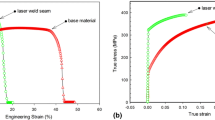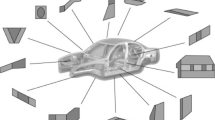Abstract
With the development of lightweight vehicles, tailor-welded blanks (TWBs) are being increasingly used in the automotive industry. Splitting and wrinkling are the main defects occurring during the deep drawing of TWBs. Accordingly, in this paper, a new method to control the forming defects is introduced in the forming process of TWBs. The microstructure and mechanical properties of TWBs are characterised by metallography and tensile tests. Finite element analysis is conducted for an automobile rear door inner panel made of TWBs to analyse the deep drawing. Edge and notch cutting are introduced to address forming defects and reduce the number of stamping tools. The thinning index, thickening index and minimum distance between the material draw-in and trimming lines are defined as the measurable index to analyse the numerical results. Orthogonal experiments, numerical simulations and multiobjective experiments are conducted to optimise the forming parameters. The proposed method and optimised parameters are verified through experiments, the results of which are essentially consistent with the numerical simulation. Indeed, the proposed method can provide guidance in controlling defects associated with the deep drawing of TWBs for complex-shape automotive panels.














Similar content being viewed by others
Availability of data and materials
The authors declare that all date and material support their published claims and comply with field standards.
References
Wu T, Shen Q, Xu M, Peng T, Ou X (2018) Development and application of an energy use and CO2 emissions reduction evaluation model for China’s online car hailing services. Energy 154:298–307. https://doi.org/10.1016/j.energy.2018.04.130
Kaluza A, Kleemann S, Fröhlich T, Herrmann C, Vietor T (2017) Concurrent design & life cycle engineering in automotive lightweight component development. Procedia CIRP 66:16–21. https://doi.org/10.1016/j.procir.2017.03.293
Kong H, Chao Q, Rolfe B, Beladi H (2019) One-step quenching and partitioning treatment of a tailor welded blank of boron and TRIP steels for automotive applications. Mater Des. https://doi.org/10.1016/j.matdes.2019.107799
Saunders FI, Wagoner RH (1996) Forming of tailor-welded blanks MMTA 27(9):2605–2616. https://doi.org/10.1007/BF02652354
Song Y, Hua L (2014) Influences of thickness ratio of base sheets on formability of tailor welded blanks. Procedia Engineering 81:730–735. https://doi.org/10.1016/j.proeng.2014.10.068
Pallett RJ, Lark RJ (2001) The use of tailored blanks in the manufacture of construction components. J Mater Process Technol 117(1):249–254. https://doi.org/10.1016/S0924-0136(01)01124-4
Wang H, Zhou J, Zhao TS, Liu LZ, Liang Q (2016) Multiple-iteration springback compensation of tailor welded blanks during stamping forming process. Mater Des 102:247–254. https://doi.org/10.1016/j.matdes.2016.04.032
Merklein M, Johannes M, Lechner M, Kuppert A (2014) A review on tailored blanks—production, applications and evaluation. J Mater Process Technol 214(2):151–164. https://doi.org/10.1016/j.jmatprotec.2013.08.015
Kinsey BL (2011) 7 - Tailor welded blanks for the automotive industry. In: Kinsey BL, Wu X (ed) Tailor welded blanks for advanced manufacturing. Woodhead Publishing, pp 164–180. https://doi.org/10.1533/9780857093851.2.164
Basak S, Katiyar BS, Orozco-Gonzalez P, Baltazar-Hernandez VH, Arora KS, Panda SK (2019) Microstructure, forming limit diagram, and strain distribution of pre-strained DP-IF steel tailor–welded blank for auto body application. Int J Adv Manuf Technol 104:1749–1767. https://doi.org/10.1007/s00170-019-03938-1
Zadpoor AA, Sinke J (2010) 10 - Weld metal ductility and its influence on formability of tailor welded blanks. In: Sun X (ed) Failure Mechanisms of Advanced Welding Processes. Woodhead Publishing, pp 258–288. https://doi.org/10.1533/9781845699765.258
Schwinn J, Besel M (2019) Determination of residual stresses in tailored welded blanks with thickness transition for crack assessment. Eng Fract Mech 208:209–220. https://doi.org/10.1016/j.engfracmech.2019.01.010
Köklü U (2013) Investigation into the formability of Al-1050 tailor-welded blanks with antilock braking system. Int J Adv Manuf Technol 66(1):221–229. https://doi.org/10.1007/s00170-012-4320-z
Russo Spena P, Cortese L, Nalli F, Májlinger K (2019) Local formability and strength of TWIP-TRIP weldments for stamping tailor welded blanks (TWBs). Int J Adv Manuf Technol 101(1):757–771. https://doi.org/10.1007/s00170-018-2946-1
Abbasi M, Ketabchi M, Ramazani A, Abbasi M, Prahl U (2012) Investigation into the effects of weld zone and geometric discontinuity on the formability reduction of tailor welded blanks. Comp Mater Sci 59:158–164. https://doi.org/10.1016/j.commatsci.2012.02.039
Bandyopadhyay K, Basak S, Panda SK, Saha P (2015) Use of stress based forming limit diagram to predict formability in two-stage forming of tailor welded blanks. Mater Des 67:558–570. https://doi.org/10.1016/j.matdes.2014.10.089
Zadpoor AA, Sinke J, Benedictus R (2007) Mechanics of tailor welded blanks: an overview. Key Eng Mat 344:373–382. https://www.scientific.net/KEM.344.373
Ciubotariu V, Brabie G (2011) Weld line behaviour during uniaxial tensile testing of tailor welded blanks. Arch Civ Mech Eng 11(4):811–824. https://doi.org/10.1016/S1644-9665(12)60079-X
Xu F, Sun G, Li G, Li Q (2014) Experimental investigation on high strength steel (HSS) tailor-welded blanks (TWBs). J Mater Process Technol 214(4):925–935. https://doi.org/10.1016/j.jmatprotec.2013.11.018
Miles MP, Nelson TW, Decker BJ (2004) Formability and strength of friction-stir-welded aluminum sheets. MMTA 35(11):3461–3468. https://doi.org/10.1007/s11661-004-0183-8
Rossini M, Spena PR, Cortese L, Matteis P, Firrao D (2015) Investigation on dissimilar laser welding of advanced high strength steel sheets for the automotive industry. Mat Sci Eng A-Struct 628:288–296. https://doi.org/10.1016/j.msea.2015.01.037
Liu J, Wang A, Gao H, Gandra J, Beamish K, Zhan L, Wang L (2018) Transition of failure mode in hot stamping of AA6082 tailor welded blanks. J Mater Process Technol 257:33–44. https://doi.org/10.1016/j.jmatprotec.2018.02.028
Gomes T, Silva FJG, Campilho RDGS (2017) Reducing the simulation cost on dual-phase steel stamping process. Procedia Manufacturing 11:474–481. https://doi.org/10.1016/j.promfg.2017.07.138
Sigvant M, Pilthammar J, Hol J, Wiebenga JH, Chezan T, Carleer B, den Boogaard T (2019) Friction in sheet metal forming: influence of surface roughness and strain rate on sheet metal forming simulation results. Procedia Manufacturing 29:512–519. https://doi.org/10.1016/j.promfg.2019.02.169
Wang AL, Liu J, Gao HX, Wang LL, Masen M (2017) Hot stamping of AA6082 tailor welded blanks: experiments and knowledge-based cloud – finite element (KBC-FE) simulation. J Mater Process Technol 250:228–238. https://doi.org/10.1016/j.jmatprotec.2017.07.025
Gautam V, Kumar A (2019) Experimental and numerical studies on formability of tailor welded blanks of high strength steel. Procedia Manufacturing 29:472–480. https://doi.org/10.1016/j.promfg.2019.02.164
Qiu XG, Chen WL (2007) The study on numerical simulation of the laser tailor welded blanks stamping. J Mater Process Technol 187–188:128–131. https://doi.org/10.1016/j.jmatprotec.2006.11.128
Zadpoor AA, Sinke J, Benedictus R (2011) 4 - Numerical simulation modeling of tailor welded blank forming. In: Kinsey B L, Wu X (ed) Tailor Welded Blanks for Advanced Manufacturing. Woodhead Publishing, pp 68–94. https://doi.org/10.1533/9780857093851.1.68
Raymond SD, Wild PM, Bayley CJ (2004) On modeling of the weld line in finite element analyses of tailor-welded blank forming operations. J Mater Process Technol 147(1):28–37. https://doi.org/10.1016/j.jmatprotec.2003.09.005
Buste A, Lalbin X, Worswick MJ, Clarke JA, Altshuller B, Finn M, Jain M (2000) Prediction of strain distribution in aluminum tailor welded blanks for different welding techniques. Can Metall Quart 39(4):493–502. https://doi.org/10.1179/cmq.2000.39.4.493
ASTM E8/E8M–21 (2021) Standard test methods for tension testing of metallic materials ASTM International, West Conshohocken, PA. https://doi.org/10.1520/E0008_E0008M-21
Gong H, Wang S, Knysh P, Korkolis YP (2016) Experimental investigation of the mechanical response of laser-welded dissimilar blanks from advanced- and ultra-high-strength steels. Mater Des 90:1115–1123. https://doi.org/10.1016/j.matdes.2015.11.057
Sun Y, Li Y, Daniel WJT, Meehan PA, Liu Z, Ding S (2017) Longitudinal strain development in Chain-die forming AHSS products: analytical modelling, finite element analysis and experimental verification. J Mater Process Technol 243:322–334. https://doi.org/10.1016/j.jmatprotec.2016.12.019
Gronostajski Z, Pater Z, Madej L, Gontarz A, Lisiecki L, Łukaszek-Sołek A, Łuksza J, Mróz S, Muskalski Z, Muzykiewicz W, Pietrzyk M, Śliwa RE, Tomczak J, Wiewiórowska S, Winiarski G, Zasadziński J, Ziółkiewicz S (2019) Recent development trends in metal forming. Arch Civ Mech Eng 19(3):898–941. https://doi.org/10.1016/j.acme.2019.04.005
Banabic D (2010) Sheet metal forming processes. Springer, Berlin, Heidelberg. https://doi.org/10.1007/978-3-540-88113-1
Firat M, Karadeniz E, Yenice M, Kaya M (2013) Improving the accuracy of stamping analyses including springback deformations. J Mater Eng Perform 22:332–337. https://doi.org/10.1007/s11665-012-0257-5
Ouyang BY (2012) Numerical simulation of drawing process for laser tailor-welded blank of car door inner plate. Forging & Stamping Technology 37(1):41–44. https://doi.org/10.3969/j.issn.1000-3940.2012.01.012
Wen T, Wang H, Yang C, Liu LT (2014) On a reshaping method of clinched joints to reduce the protrusion height. Int J Adv Manuf Technol 71(9):1709–1715. https://doi.org/10.1007/s00170-014-5612-2
Xu F, Zhang S, Wu K, Dong Z (2018) Multi-response optimization design of tailor-welded blank (TWB) thin-walled structures using Taguchi-based gray relational analysis. Thin Wall Struct 131:286–296. https://doi.org/10.1016/j.tws.2018.07.007
Funding
This research was supported by the Science and Technology Research Program of Chongqing Municipal Education Commission (No. KJQN201801228), Chongqing Natural Science Foundation (No. CSTC2019JCYJ-MSXM1349) and Chongqing Artificial Intelligence and Wisdom Agriculture Funds (ZNNYKFB201902).
Author information
Authors and Affiliations
Contributions
H. Wang designed the study, performed the research, analysed data and wrote the paper. L.Z. Liu has carried out the mechanics experiment and microscopic characterization. H.B. Wang and J. Zhou has revised the manuscript.
Corresponding author
Ethics declarations
Consent to participate
The authors declare that they consent to participate in this paper.
Consent to publish
This manuscript is approved by all authors for publication.
Conflict of interest
The authors declare no competing interests.
Additional information
Publisher's Note
Springer Nature remains neutral with regard to jurisdictional claims in published maps and institutional affiliations.
Rights and permissions
About this article
Cite this article
Wang, H., Liu, L., Wang, H. et al. Control of defects in the deep drawing of tailor-welded blanks for complex-shape automotive panel. Int J Adv Manuf Technol 119, 3235–3245 (2022). https://doi.org/10.1007/s00170-021-08406-3
Received:
Accepted:
Published:
Issue Date:
DOI: https://doi.org/10.1007/s00170-021-08406-3




